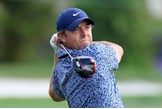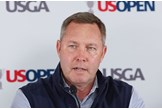Golf ball rollback will reduce Tour pro’s driving distances by 15 yards
Published: Last updated:
R&A and USGA seek to tackle the impact of distance in the professional game with a new rule that will limit how far golf balls travel.
Golf’s rule-makers have proposed a Model Local Rule (MLR) that gives competition organizers the option to require the use of golf balls that are tested under modified launch conditions to address the impacts of hitting distance in golf.
The MLR is intended for use only in elite competitions and, if adopted, will have “zero impact on recreational golf”. According to the governing bodies, these changes would reduce the average driving distance of elite players by 14 to 15 yards and it would take another 15 years of technology developments for distances to reach those that we see today.
During a press conference to announce the changes on Tuesday (March 12), R&A CEO Martin Slumbers and USGA CEO Mike Whan both confirmed that they would adopt the local rule for championships under their jurisdiction and said that doing nothing about distance would be “borderline irresponsible”.
The proposal notice was sent to golf equipment manufacturers on March 13, following the Equipment Rulemaking Procedures established by the governing bodies in 2011. Manufacturers and golf stakeholders can provide feedback until August 14, 2023. If adopted, the proposal would take effect in January 2026.

Golf balls that conform to the MLR must not exceed the current Overall Distance Standard (ODS) limit of 317 yards (plus three yards tolerance) at modified Actual Launch Conditions (ALC) with a clubhead speed of 127 mph and based on a calibration set-up for 11 degrees and 37 revolutions per second (2,220rpm) as part of this proposal.
All other balls, including those typically used by recreational golfers with lower swing speeds, would continue to be tested using the existing ALC values (120 mph, and a calibration set-up of 10 degrees and 42 revolutions per second – 2,520 rpm). The current ODS limit of 317 yards will remain unchanged and would be applied to both testing set-ups.
The Overall Distance Standard was established in 1976 as a ball test intended to reflect the maximum potential hitting distance by the longest hitters currently playing the game.
There is a direct correlation between clubhead speed and hitting distance (further research having been published in the Distance Insights reports). Over the last 20 years hitting distance has increased on average by around one yard per year.
The modified testing set-up in the proposed MLR is expected to reduce hitting distance by 14-15 yards on average for the longest hitters with the highest clubhead speeds.

“We have worked closely with the golf industry throughout this process and taken time to listen carefully to their perspectives and reflect on the helpful and constructive feedback they have provided,” said Slumbers, above.
“At the core of our proposal is a desire to minimize the impact on a flourishing recreational game. We believe the proposed Model Local Rule will help us move forward in a way that protects the inherent qualities of the sport and reduces the pressure to lengthen courses.
“This is an important issue for golf and one which needs to be addressed if the sport is to retain its unique challenge and appeal.”

Whan said the increase in the distances the ball travels across the past 60 years had led to the move.
“It’s been two decades since we last revisited our testing standards for ball distances. Predictable, continued increases will become a significant issue for the next generation if not addressed soon.
“The MLR we are proposing is simple to implement, forward-looking and does so without any impact on the recreational game. We are taking the next steps in this process, guided first and foremost by doing what’s right by the entire game.”
The governing bodies have consulted closely with the golf industry throughout the Distance Insights project, which commenced in 2018 but has been of continual study over at least the last two decades.
This is the fourth formal feedback period to be opened in the last five years, in addition to continuing stakeholder engagement across the game, including golfers, fans, competition organizers, equipment manufacturers, golf course owners, superintendents, architects and others.

Based on feedback received from manufacturers, The R&A and the USGA are no longer considering the use of launch conditions that are optimized for each individual golf ball model to evaluate conformance. Similarly, they are not pursuing a reduction in the characteristic time limit in the existing Equipment Standards or changes to the Moment of Inertia limit of drivers at this time.
The R&A and USGA set out to address the long-term trend of increased hitting distances and course lengthening that they believe threaten golf’s long-term sustainability and undermines the core principle that a broad and balanced set of playing skills should remain the primary determinant of success in golf.
The findings of extensive research by the governing bodies into distance (along with the supporting research and data) were set out within the Distance Insights report into the Implications of Hitting Distance in February 2020 under two key themes: the pressure on courses to continue to lengthen and ensuring that distance did not become predominant in the balance of skills required in golf.

The report also found that the overall trend of golf courses becoming longer has adverse consequences, including by increasing the cost and time to play, limiting the advancement of sustainability efforts and reducing the challenge of courses – in some cases creating a risk of them becoming obsolete.
The 2022 Annual Driving Distance Report, which aggregates hitting distance data reported by seven professional men’s and women’s tours worldwide, showed that the average clubhead speed on the PGA Tour was 114.6 mph last year, with an average launch angle of 10.3° and average spin of 2,597rpm. The mean of the fastest one percent of clubhead speeds was 127.5 mph in 2022, while the mean of the fastest five percent of clubhead speeds was 124.2mph.
The Annual Driving Distance Report also reports a four percent average year-over-year increase in hitting distance across all seven tours, with all but the Japan Golf Tour and LPGA Tour reporting the longest values on record. The Korn Ferry Tour recorded the highest annual hitting average across all tours in 2022, at 307.8 yards.
READ NEXT
– Best Golf Balls
Join Today’s Golfer for unlimited access to premium content and exclusive rewards!


